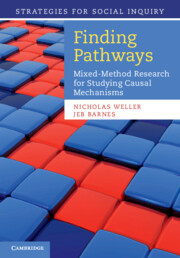Book contents
- Frontmatter
- Contents
- List of figures
- List of tables
- Acknowledgments
- 1 Pathway analysis and the elusive search for causal mechanisms
- 2 Preparing for pathway analysis
- 3 Case selection for pathway analysis
- 4 Comparison of case selection approaches
- 5 Regression-based case selection for pathway analysis of non-linear relationships
- 6 Matching to select cases for pathway analysis
- 7 Using large-N methods to gain perspective on prior case studies
- 8 Pathway analysis and future studies of mechanisms
- 9 Conclusion
- Glossary of terms
- References
- Index
7 - Using large-N methods to gain perspective on prior case studies
Published online by Cambridge University Press: 05 July 2014
- Frontmatter
- Contents
- List of figures
- List of tables
- Acknowledgments
- 1 Pathway analysis and the elusive search for causal mechanisms
- 2 Preparing for pathway analysis
- 3 Case selection for pathway analysis
- 4 Comparison of case selection approaches
- 5 Regression-based case selection for pathway analysis of non-linear relationships
- 6 Matching to select cases for pathway analysis
- 7 Using large-N methods to gain perspective on prior case studies
- 8 Pathway analysis and future studies of mechanisms
- 9 Conclusion
- Glossary of terms
- References
- Index
Summary
Introduction
So far in this book we have focused on using various quantitative methods to guide case selection in order to explore the substantive relationship between a key explanatory variable (X1) and an outcome (Y). The discussion assumes that, in some settings, researchers do not have strong reasons for selecting particular cases, and so are using quantitative data to determine case selection. However, in other cases, researchers often have compelling reasons for examining certain cases, including theoretical, empirical, and practical reasons (such as access to data sources, cost effectiveness, and preexisting expertise). Under these circumstances, the issue is not which cases to choose initially, but how to gain perspective on the cases already chosen and perhaps how to choose cases for additional analysis.
This chapter illustrates how large-N data can help gain perspective on previously chosen cases by shedding light on how they fit within the broader universe of cases that could have been chosen, thus providing some leverage over how the extant case studies compare to unstudied cases. This can help a researcher understand how to generalize to unstudied cases and how to identify future cases that might offer promising comparisons.
The use of large-N data to gain perspective on previously selected cases is best explored by example. In this chapter we focus on the relationship between natural resources (X1) and civil conflict (Y), which was also the focus of Chapter 6.We first explain why this example is useful, then we review the existing pathway analyses conducted by Michael Ross (2004) and the large-N data analysis of Paul Collier and Anke Hoeffler (2004), and finally we demonstrate how to use the large-N data to gain some perspective on the cases selected by Ross and how to identify avenues for future inquiry.
- Type
- Chapter
- Information
- Finding PathwaysMixed-Method Research for Studying Causal Mechanisms, pp. 104 - 116Publisher: Cambridge University PressPrint publication year: 2014

